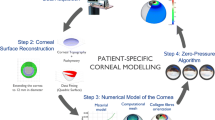Abstract
This paper proposed an improved point based method to simulate the deformation and cutting of cornea, realized the real-time interaction between the force feedback device and the model in virtual surgery. We construct a hybrid deformable model, the model consists of two parts: the interior of the cornea consists of some particles, and the boundary consists of some meshes which are formed by surfaces nodes, calculate the stress tensor of particle can simulate corneal deformation. In this process, in order to ensure the stability of the deformation, a volume constraint is added to our model. By sampling on the surface of the model to form some meshes, the model could support the changes of topology. Using a node replication method for surface cutting and subdivide the cutting triangles in the cutting process, so that it can generate relatively smooth incision. Experiments show that the model provides a real and efficient deformation simulation, with good stability and scalability.













Similar content being viewed by others
References
Bianchi G, Solenthaler B, Székely G, et al (2004) Simultaneous topology and stiffness identification for mass-spring models based on FEM reference deformations [C]// Medical Image Computing and Computer-Assisted Intervention -- Miccai 2004, International Conference Saint-Malo, France, September 26-29, 2004, Proceedings. DBLP, p 293–301
Bianchi G, Solenthaler B, Székely G et al (2004) Simultaneous topology and stiffness identification for mass-spring models based on fem reference deformations [J]. Med Image Comput Comput Assist Interv 2004:293–301
Busaryev O, Dey TK, Wang H (2013) Adaptive fracture simulation of multi-layered thin plates [M]. ACM
Camara M, Mayer E, Darzi A et al (2016) Soft tissue deformation for surgical simulation: a position-based dynamics approach [J]. Int J Comput Assist Radiol Surg 11(6):919–928
Choi KS, Soo S, Chung FL (2009) A virtual training simulator for learning cataract surgery with phacoemulsification [J]. Comput Biol Med 39(11):1020–1031
Faure F, Gilles B, Bousquet G et al (2011) Sparse meshless models of complex deformable solids [J]. ACM Trans Graph 30(4):1–10
Guo X, Qin H (2010) Real-time meshless deformation [J]. Comput Animat Virt W 16(3-4):189–200
Hong M, Jung S, Choi MH et al (2006) Fast volume preservation for a mass-spring system [J]. IEEE Comput Graph Appl 26(5):83–91
Jung H, Lee DY (2012) Real-time cutting simulation of meshless deformable object using dynamic bounding volume hierarchy [M]. John Wiley and Sons Ltd.
Kaufmann P, Martin S, Botsch M et al (2009) Enrichment textures for detailed cutting of shells [J]. ACM Trans Graph 28(3):1–10
Lim YJ, Hu J, Chang CY, et al (2006) Soft tissue deformation and cutting simulation for the multimodal surgery training [C]// IEEE Symposium on Computer-Based Medical Systems. IEEE Computer Society, p 635-640
Liu Y, Jiao S, Wu W, et al (2009) GPU accelerated fast FEM deformation simulation [C]// Circuits and Systems, 2008. APCCAS 2008. IEEE Asia Pacific Conference on. IEEE, p 606-609
Markus B, Markus I, Matthias T (2009) Corotated SPH for deformable solids [C]. Eurographics Workshop on Natural Phenomena, NPH 2009, Munich, Germany
Müller M, Keiser R, Nealen A, et al (2004) Point based animation of elastic, plastic and melting objects [C]// ACM Siggraph/eurographics Symposium on Computer Animation. Eurographics Association, p 141–151
Müller M, Heidelberger B, Teschner M, et al (2005) Meshless deformations based on shape matching [C]// Acm Siggraph. ACM, p 471–478
Müller M, Heidelberger B, Hennix M et al (2007) Position based dynamics ☆[J]. J Vis Commun Image Represent 18(2):109–118
Pauly M, Keiser R, Adams B et al (2005) Meshless animation of fracturing solids [J]. ACM Trans Graph 24(3):957
Peng Y, Jia R, Wang Y et al (2011) A virtual endoscopy system for virtual medicine [J]. Comput Animat Virt W 22(2-3):277–284
Peng Y, Ma Y, Wang Y et al (2017) The application of interactive dynamic virtual surgical simulation visualization method [J]. Multimed Tools Appl:1–18
Selle A, Lentine M, Fedkiw R (2008) A mass spring model for hair simulation [J]. ACM Trans Graph 27(3):1–11
Shrivastava P, Das S (2014) Particle coding for Meshfree cutting of deformable assets [C]// Indian Conference on Computer Vision Graphics and Image Processing. ACM, p 6
Solenthaler B, Schläfli J, Pajarola R (2007) A unified particle model for fluid–solid interactions: research articles [J]. Comput Animat Virt W 18(1):69–82
Wang Y, Wu X, Wang G (2014) An angle bending constraint model for position-based dynamics [C]// International Conference on Virtual Reality and Visualization. IEEE, p 430-434
Wicke M, Botsch M, Gross M (2007) A finite element method on convex polyhedra [C]// Computer Graphics Forum. Blackwell Publishing Ltd, p 355–364
Zhu B, Gu L (2012) A hybrid deformable model for real-time surgical simulation [J]. Comput Med Imaging Graph 36(5):356–365
Acknowledgments
This work is supported by the National key research and development project of China under Grant No.2016YFC0801406, the Natural Science Foundation of Shandong Province under Grant No. ZR2015FM013, the National Natural Science Foundation of China under Grant No. 61502279, the National key research and development project of the Shandong Province under Grant No. 2016GSF120012, and by Special Project Fund of Taishan Scholars of Shandong Province, Leading Talent Project of Shandong University of Science and Technology.
Author information
Authors and Affiliations
Corresponding author
Additional information
Publisher’s Note
Springer Nature remains neutral with regard to jurisdictional claims in published maps and institutional affiliations.
Rights and permissions
About this article
Cite this article
Peng, Y., Li, Q., Yan, Y. et al. Real-time deformation and cutting simulation of cornea using point based method. Multimed Tools Appl 78, 2251–2268 (2019). https://doi.org/10.1007/s11042-018-6343-4
Received:
Revised:
Accepted:
Published:
Issue Date:
DOI: https://doi.org/10.1007/s11042-018-6343-4




